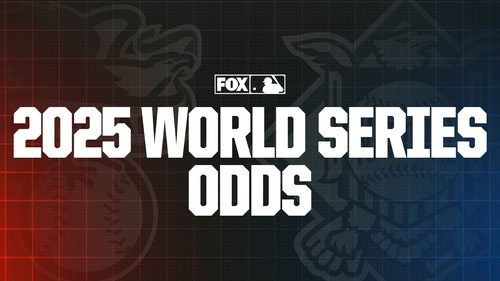
Matt Chapman has been the best hitter in baseball — and a payday could be coming
Pick a stat, ranging from traditional measures like batting average to new school metrics like WAR or barrel rate. Chances are, you’ll find Matt Chapman perched atop the leaderboard.
Long known for his exquisite glove work at the hot corner headlining a power-over-hit profile at the plate, the 30-year-old Blue Jays third baseman has elevated his offensive game to outrageous new heights in 2023, and it couldn’t be coming at a better time.
In the wake of Rafael Devers’ mega extension with the Red Sox and (correctly) assuming Manny Machado would also soon be locked up long term in San Diego, I tabbed Chapman in January as the strongest candidate to be the top free-agent hitter available this upcoming winter after Shohei Ohtani.
At the time, I suggested that if he regained the fringe-MVP candidate form he demonstrated in 2018-2019 with the A's, he’d really be in line for quite the payday — especially with Scott Boras as his agent. But I wasn’t exactly counting on that, and felt that if he simply stayed healthy and held serve as a damn good third baseman with power, he’d do quite well for himself on the open market regardless.
Well, forget rediscovering his peak from a few years back, let alone holding serve. Through the first month, this is the best version of Chapman we’ve ever seen.
Through Monday’s games, Chapman leads MLB in both bWAR and fWAR. He leads all AL hitters in batting average, doubles and total bases. Not that you could fluke your way into leading all those categories over a month’s worth of games, but Chapman’s batted ball data only further reinforces just how good he’s been over the first month. While he may only have five homers, his 24 barrels leads both leagues by a comfortable margin, with Randy Arozarena in second place with 17. He’s also second in both hard-hit rate (% of balls in play with a 95-plus MPH exit velocity) and average exit velocity behind only resurgent slugger Joey Gallo.
Chapman’s residence in the penthouse of exit velocity shouldn’t come as that much of a shock. Hitting the ball hard has always been his thing, with Chapman ranking in at least the 93rd percentile for average exit velocity in four of the past five seasons. What is surprising, is the consistency with which he’s been able to make such quality contact.
Strikeout-prone hitters — even really good ones — can generally be put into one of two buckets: those who chase pitches out of the zone and those who whiff at pitches in the zone. (Those who frequently do both are probably striking out too much to still be good.) Chapman has consistently swung at the right pitches over the course of his career, routinely running chase rates well below league-average along with strong walk rates. But over the past three seasons, Chapman’s in-zone contact rate dropped below 80% (league-average is about 85%), while his overall whiff rates plummeted to the bottom-fifth of the league, spiking his overall strikeout rate to roughly 30%.
So far this year, Chapman has course-corrected in dramatic fashion. His in-zone contact rate is at a career-high 87.5%, while his whiff rate is back down to a manageable 9%, much more in line with his 2018-2019 campaigns when his overall offensive production was much more substantial.
The driving force behind these outstanding early results seems to be an increased emphasis on hitting the ball up the middle and to right-center field rather than trying to pull everything, something Chapman talked about as a focus in spring training. It may feel cliché to hear a hitter emphasize the importance of using the whole field or going the other way, but Chapman wasn’t just talking the talk: he’s pulled a career-low 32.9% of the balls he’s put in play thus far this season, a stunning drop from the career 42.2% pull rate he had coming into the year.
This new approach hasn’t just opened up more of the field for potential extra-base exploits, it’s clearly enabled a more reliable swing that has produced far more contact on the whole. And for players who hit the ball as hard as Chapman does, any strides made toward putting more balls in play can yield massive results. That’s exactly what we’ve seen thus far in 2023.
As for his overall value, it’s worth noting that the advanced defensive metrics by which he excelled earlier in his career haven't been quite as favorable in recent years. While the eye-test suggests he can still pick it with the best of ‘em, I’m willing to accept that his Gold Glove days may be behind him. But what if this really is who Chapman the hitter can be? I’ll respectfully take the under on the 1.132 OPS for the season, but let's say he finishes at .900. That would still represent a career high and an OPS+ around 140.
He’ll certainly reap the rewards financially in free agency assuming the Jays don’t extend him.
His current play also begs the question: How should we view Chapman relative to the other best players at his position?
With Chapman leading MLB in WAR through the first month of 2023, consider his rankings among primary third basemen by bWAR and fWAR in each of the previous five seasons:
2018: 7.6 bWAR (2nd)/6.3 fWAR (3rd)
2019: 7.8 bWAR (2nd)/5.7 fWAR (5th)
2020: 1.2 bWAR (10th)/1.1 fWAR (11th)
2021: 3.5 bWAR (10th)/4.1 fWAR (6th)
2022: 3.5 bWAR (10th)/4.1 fWAR (7th)
Oddly enough, Chapman is surging at a time when two of the gold standards at his position — Machado and Nolan Arenado — have uncharacteristically struggled (and significantly), underscoring what has been a strange year at the position. Alex Bregman — the only third baseman who posted more bWAR than Chapman in both 2018 and 2019 — has also gotten off to a slow start in 2023. Max Muncy has returned to the hot corner full-time and is mashing, as is journeyman slugger Patrick Wisdom for the Cubs. Three proven superstars in Devers, Austin Riley and José Ramírez have been more good than great. Anthony Rendon — a superstar stalwart at the position not too long ago — has zero homers. Ke’Bryan Hayes is a marvelous defender but is slugging .370; Jake Burger is slugging .661, but isn’t exactly the rangiest fella. It’s obviously too early to consider Brett Baty and Josh Jung in the inner-circle of third basemen, but they’ve had promising starts.
All of which is to say: Chapman having a career season in his platform year would stand out in a weak free-agent class no matter what. But helping his case even further may be the degree to which he now stands out among his positional peers. "Top-five third baseman" could end up being quite the elevator pitch for Boras this winter.
Jordan Shusterman is half of @CespedesBBQ and a baseball writer for FOX Sports. He has covered baseball for his entire adult life, most notably for MLB.com, DAZN and The Ringer. He's a Mariners fan living in the Eastern Time Zone, which means he loves a good 10 p.m. first pitch. You can follow him on Twitter @j_shusterman_.










